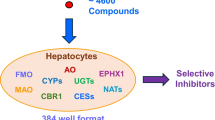Abstract
Carboplatin (CPT), today the most important platinum(II) anticancer drug, manifests an extreme kinetic inertness, in vitro, at physiological pH; the actual mechanisms for its activation inside cells are still poorly understood. We show here that horse heart cytochrome c reacts with CPT, leading to the formation of stable platinum/protein adducts. The two major CPT–cytochrome c species resulting from the aforementioned reaction were characterised by electrospray ionisation mass spectrometry (ESI-MS). Notably, both these adducts have the ability to react with guanosine 5′-monophosphate (5′-GMP), giving rise to the respective cytochrome c–CPT–5′-GMP ternary complexes. Additional ESI-MS measurements on enzymatically cleaved cytochrome c adducts suggest that protein platination probably occurs at Met65. The mechanistic implications of these findings are discussed.









Similar content being viewed by others
Abbreviations
- cbdca:
-
1,1-Cyclobutanedicarboxylate
- CPT:
-
Carboplatin
- en:
-
Ethylenediamine
- ESI:
-
Electrospray ionisation
- 5′-GMP:
-
Guanosine 5′-monophosphate
- MS:
-
Mass spectrometry
- TMeAmAc:
-
Tetramethylammonium acetate
References
Wang D, Lippard SJ (2005) Nat Rev Drug Discov 4:307–320
Robillard MS, Reedijk J (2005) Platinum-based anticancer drugs. In: King RB (ed) Encyclopedia of inorganic chemistry, 2nd edn. Wiley, Chichester, pp 4488–4498
Canovese L, Cattalini L, Chessa G, Tobe ML (1988) J Chem Soc Dalton Trans 2135–2140
Hay RW, Miller S (1998) Polyhedron 17:2337–2343
Brabec V (2002) Prog Nucl Acid Res Mol Biol 71:1–68
Miller SE, House DA (1989) Inorg Chim Acta 166(2):189–197
Barnham KJ, Djuran MI, Murdoch PS, Ranford JD, Sadler PJ (1996) Inorg Chem 35(4):1065–1072
Kleine M, Wolters D, Sheldrick WSJ (2003) Inorg Biochem 97(4):354–363
Kung A, Zenker A, Galanski M, Keppler BKJ (2001) Inorg Biochem 3(2–3):181–186
Esposito BP, Najjar R (2002) Coord Chem Rev 232:137–149
Xie R, Johnson W, Rodriguez L, Gounder M, Hall GS, Buckley B (2007) Anal Bioanal Chem 387(8):2815–2822
Liu S, Liu Y, Li J, Guo M, Nie L, Yao S (2005) J Biochem Biophys Methods 63(2):125–136
Mandal R, Kalke R, Li XF (2004) Chem Res Toxicol 17(10):1391–1397, erratum in Chem Res Toxicol (2005) 18(9):1506
Knipp M, Karotki A, Chesnov S, Natile G, Sadler PJ, Brabec V, Vasak M (2007) J Med Chem 50(17):4075–4086
Xie R, Johnson W, Rodriguez L, Gounder M, Hall GS, Buckley B (2007) Anal Bioanal Chem 387(8):2815–2822
Yang G, Miao R, Jin C, Mei Y, Tang H, Hong J, Guo Z, Zhu L (2005) J Mass Spectrom 40(8):1005–1016
Casini A, Gabbiani C, Mastrobuoni G, Messori L, Moneti G, Pieraccini G (2006) ChemMedChem 1(4):413–417
Pasini A, Caldirola C (1988) Inorg Chim Acta 151(1):19–20
Di Pasqua AJ, Goodisman J, Kerwood DJ, Toms BB, Dubowy RL, Dabrowiak JC (2006) Chem Res Toxicol 19(1):139–149
Di Pasqua AJ, Goodisman J, Kerwood DJ, Toms BB, Dubowy RL, Dabrowiak JC (2007) Chem Res Toxicol 20(6):896–904
Peleg-Shulman T, Najajreh Y, Gibson D (2002) J Inorg Biochem 91(1):306–311
Lijuan J, Yu C, Guozi T, Wenxia T (1997) J Inorg Biochem 65:73–77
Casini A, Gabbiani C, Mastrobuoni G, Pellicani RZ, Intini FP, Arnesano F, Natile G, Moneti G, Francese S, Messori L (2007) Biochemistry 46(43):12220–12230
Heudi O, Mercier-Jobard S, Cailleux A, Allain P (1999) Biopharm Drug Dispos 20:107–116
Hohage O, Sheldrick WS (2006) J Inorg Biochem 100(9):1506–1513
Acknowledgments
The authors gratefully acknowledge support from Ente Cassa di Risparmio di Firenze. A.C. and C.G. wish to thank AIRC for providing them with research fellowships.
Author information
Authors and Affiliations
Corresponding authors
Rights and permissions
About this article
Cite this article
Gabbiani, C., Casini, A., Mastrobuoni, G. et al. Peculiar mechanistic and structural features of the carboplatin–cytochrome c system revealed by ESI-MS analysis. J Biol Inorg Chem 13, 755–764 (2008). https://doi.org/10.1007/s00775-008-0361-z
Received:
Accepted:
Published:
Issue Date:
DOI: https://doi.org/10.1007/s00775-008-0361-z




